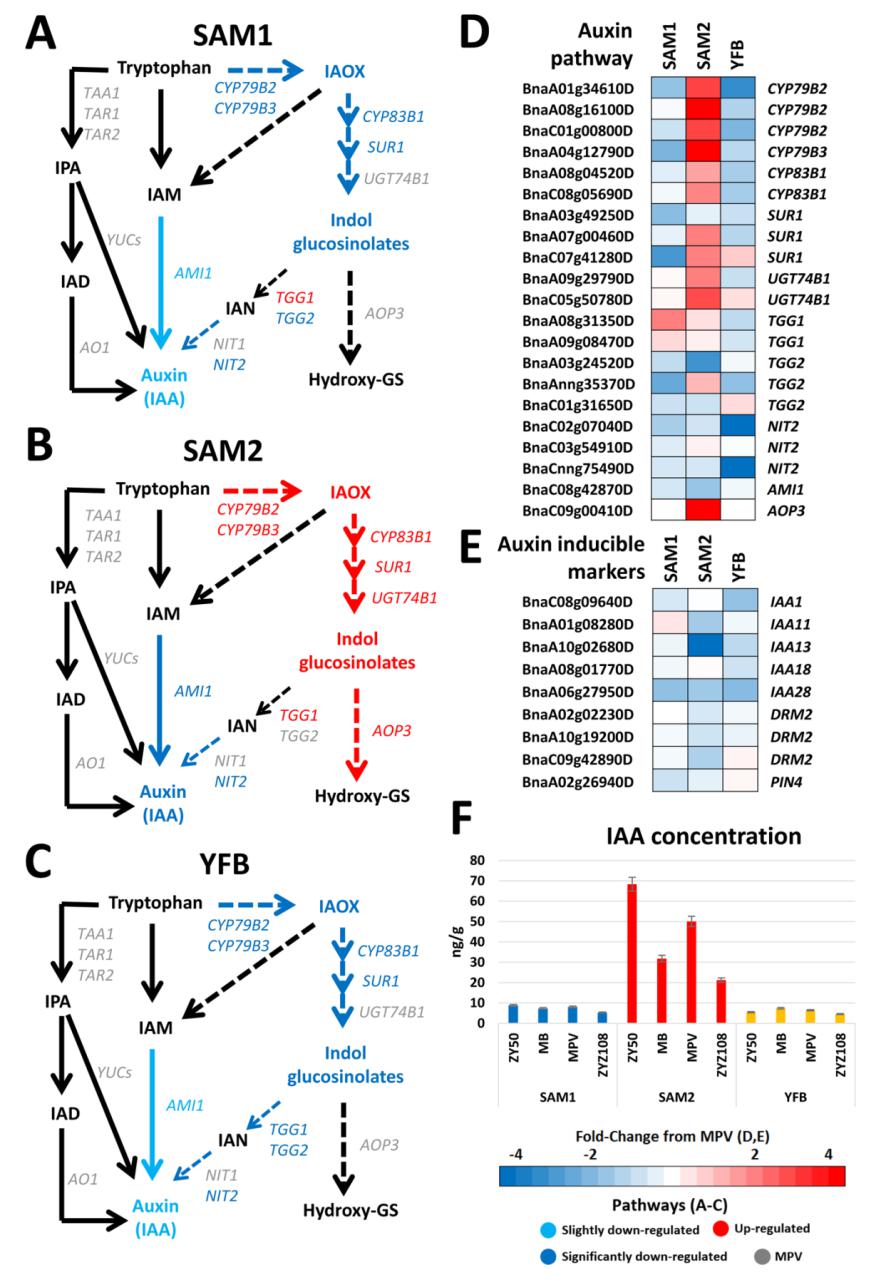浙江大学农业与生物技术学院樊龙江教授课题组通过对一个油菜杂交组合(双亲及其杂种)生长发育阶段的转录组、小RNA(sRNA)、甲基化测序及其分析,系统地揭示了油菜产量性状杂种优势的表观遗传机制。研究结果 “Analysis of transcriptional and epigenetic changes in hybrid vigor of allopolyploid Brassica napus uncovers key roles for small RNAs” 在线发表在《Plant Journal》杂志。

杂种优势是指杂交子代在生长势、生殖力、产量和抗逆性等多个性状上优于亲本的现象,在农业生产上有着非常广泛的应用。解析杂种优势的分子遗传机制,是进一步提升农作物育种效率和空间的重要理论基础。油菜是我国第一大油料作物,在我国油料生产中具有举足轻重的地位。油菜属于多倍体植物,具有复杂的基因组,这导致目前对油菜杂种优势分子机制知之甚少。
樊龙江课题组与浙江省农科院华水金副研究员合作,利用产量性状杂种优势显著的浙江省杂交油菜主栽品种“浙油杂108”及其双亲(ZH3A和浙油50)进行了多个生长时期的杂种优势研究。该研究发现,油菜角果数目的增加是导致产量杂种优势产生的主要原因。杂交子代茎尖分生组织中生长素浓度的下降,部分抑制了子代植株的顶端优势,导致分枝能够产生更多的有效角果,从而增加了产量。在杂种子代中,防卫反应(defense response)基因表达量显著下降,从而影响了子代中的能量流动平衡,用于防卫反应的能量更多的进入了生长环节,促进了植物生长及果实中的物质积累。水杨酸合成通路与生长素激素浓度的变化是导致杂种子代这一系列变化的主要原因。表观遗传分析表明,油菜杂种子代中非加性表达的小RNA发挥了重要调控作用。非加性表达的miRNA影响了对应的靶基因(涉及到蛋白质磷酸化相关途径)的表达水平,从而参与了杂种优势形成的表观调控; 24nt小干扰RNA(siRNA)的非加性表达导致了子代中基因组甲基化水平的上升,抑制了转座子的表达活性,从而影响了杂种优势的产生。该研究首次揭示了油菜产量杂种优势产生的表观遗传机制,为今后油菜育种中杂种优势利用提供了重要理论依据,同时为其他多倍体作物杂种优势分子机制研究提供了重要线索。

图1油菜杂种子代F1在三个生长发育阶段生长素IAA含量及其合成相关基因表达变化情况(SAM1——过渡分生组织时期;SAM2——花分生组织起始时期;YFB——花发育时期)
浙江大学樊龙江教授为本文的通讯作者,博士生沈一飞为第一作者。浙江省农科院华水金副研究员和来自澳大利亚、美国和德国研究者共同参与该研究。该项工作得到了国家973项目(2015CB150200)等资助。
Summary
Heterosis is a fundamental biological phenomenon characterized by the superior performance of a hybrid compared to its parents. The underlying molecular basis for heterosis, particularly for allopolyploids, remains elusive. In this study, we analyzed the transcriptomes of Brassica napus parental lines and their F1 hybrids at three stages of early flower development. Phenotypically, the F1 hybrids show remarkable heterosis in silique number and grain yield. Transcriptome analysis revealed that various phytohormones (auxin and salicylic acid) response genes are significantly altered in the F1 hybrids relative to the parental lines. We also found evidence for decreased expression divergence of the homoeologous gene pairs in the allopolyploid F1 hybrids and suggest that high-parental expression level dominance plays an important role in heterosis. Small RNA and methylation studies aimed at examining the epigenetic effect of the gene expression level changes in the F1 hybrids showed that the majority of the small interfering RNA (siRNA) clusters had a higher expression level in the F1 hybrids than parents, and that there was an increase of the genome-wide DNA methylation in the F1 hybrid. Transposable elements associated with siRNA clusters had a higher level of methylation and a lower expression level in the F1 hybrid, implying that the non-additively expressed siRNA clusters resulted in lower activity of the transposable elements through DNA methylation in the hybrid. Our data provide insights into the role that gene expression pattern changes and epigenetic mechanisms contribute to heterosis during early flower development in allopolyploid B. napus.

